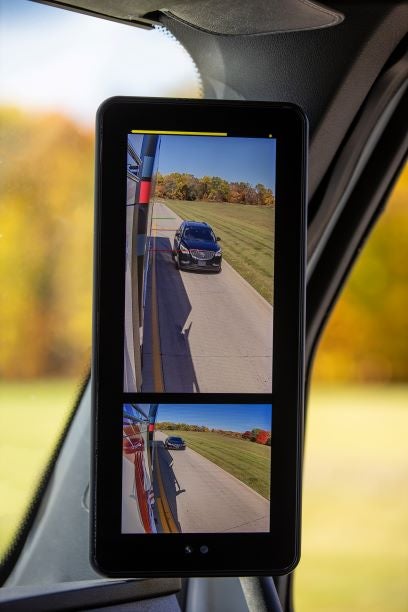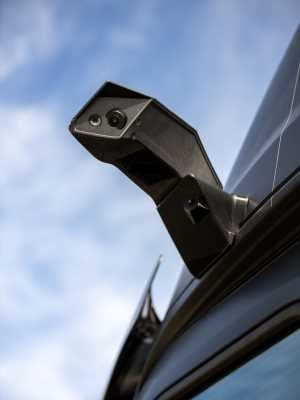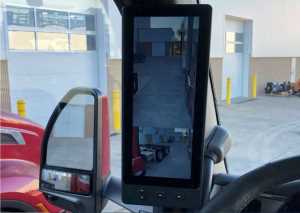Mario Gafencu wishes the Stoneridge Inc. MirrorEye Camera Monitor System (CMS) was around when he was rolling up 2.5 million accident-free miles as a professional driver. His first 20-mile drive on a snowy January day last year was all the evidence he needed.
“Regardless of all the road spray from all the vehicles on the road that day, my view of the traffic around my vehicle was clear and unobstructed,” Gafencu recalled. ” I was no longer guessing and hoping that a vehicle was not in that right front corner by the right front steer tire. With this system, I was sure for I saw clearly the whole right side of the vehicle.”
The CMS technology may be the next big thing in trucking safety and fuel efficiency. The benefit will go to other drivers now that Gafencu has moved on to lead fleet operations, testing and validation for Stoneridge (NYSE: SRI). One of his roles is describing MirrorEye’s benefits to potential customers.
During a 45-minute ride-along on Interstate 96 west of Detroit, Gafencu demonstrates camera views overlaid with green, orange and red guidelines resembling the superimposed first down markers on a televised football game. From 80 feet at the green line, they suggest how much attention a driver needs to devote to vehicles on the left and right and behind the truck.
“You’re going to watch a car come up next to us on the right side,” Gafencu narrates from behind the wheel of a 2019 Freightliner Cascadia. “And literally, I have him in all three views, possibly in two at the same time, until the car passes. Once I see his taillights, that’s when I lose sight of him here on the monitor.”

Entering surface street traffic engages the CMS panning feature.
“It always keeps the end of the trailer in view,” Gafencu said. “Then as we straighten out, it will bring it back to a default [view]. The driver can manually adjust the panning on either side to his liking when he’s backing in or just sitting at the dock and wants to see what the truck next to him is doing.”
Taking out the guesswork
Multiview monitors on the pillars — 15.3 inches tall for the driver and 12.3 inches for the passenger and a 7-inch square monitor on the upper center of the cab — display the output of five cameras. Stoneridge claims a 25% greater field of view compared to traditional Class 8 mirrors, the elimination of common blind spots and reduced driver fatigue..
“You don’t have to turn your head as much, so that’s a lot easier on the body,” Gafencu said.
No longer is backing the trailer subject to a driver’s feel and guesswork that, when wrong, can result in thousands of dollars of trailer damage. The CMS magnifies in reverse at 200%, 250% or 300% depending on driver preference.
A downward-facing camera tracks the steer tire and helps drivers reduce accidental curb checking that can damage tires. “Even if you don’t get a flat on the spot, you’re going to bust the belt inside the tire,” Gafencu said.

damage to tires. (Photo: Stoneridge Inc.)
Aerodynamic anathema
The current Federal Motor Vehicle Safety Standard requires Class 8 tractors to have mirrors on both sides of the hood measuring at least 50 square inches. Most are closer to 200 square inches. Their bulk impedes aerodynamics — how air moves around the tractor — resulting in a loss of up to a mile of fuel efficiency per gallon of diesel.
“Oftentimes you not only have the two side mirrors, which are regulated, but you’ve got fender mirrors that look down at the passenger vehicle next to you,” said Mike Roeth, executive director of the North American Council for Freight Efficiency.
Stroneridge estimates 2% to 3% fuel efficiency improvement. Even at 1%, the savings would be $600 to $700 a year per truck based on diesel at $3 per gallon, Roeth said.
Most Class 8 trucks cover 80,000 to 100,000 miles a year. The “value equation” — accounting for fuel savings, less physical damage to trailers and avoided crashes — usually works out to a one-year payback for the $4,500 retrofit, Stoneridge CEO Jon DeGaynor told FreightWaves..
Game-changing technology
The technology is game changing for drivers, said John Culp, president of Maverick Transportation, which is adding MirrorEye to all of its more than 1,000 trucks. “It’s a no-brainer, just like backup cameras are for passenger vehicles,”
Birmingham, Alabama-based Montgomery Transport also is going all-in on MirrorEye.
“The system allows me to see objects around my truck that were previously impossible to see from the driver’s seat of my cab,” said Rosko Craig, the Alabama Trucking Association’s 2019 Driver of the Year. “The infrared cameras and digital monitors provide a clear view at night and the ability to peek through rain, snow, fog and tire spray takes driving to a whole new level.”
Said Brad Corrodi, Stoneridge vice president of fleet product and services: “One of our fleets [said] their recruitment success doubled as soon as they started having MirrorEye-equipped trucks to give to the new guys,”
Long days and nights behind the wheel are not the hardest part of truck driving, NACFE’s Roeth said.
“Parking a truck, either at a dock or a truck stop, or just dropping and hooking the trailer, that’s the most difficult thing truck drivers have to do,” he said. “[Camera mirror systems] are good technology that is working in the field.”
Building the business
Including Maverick and Montgomery, Stoneridge has more than 300 MirrorEye systems in use with 24 fleets that represent 85,000 tractors. Tyson Foods (NYSE: TSN), which operates about 1,000 trucks, is testing MirrorEye and may be close to adoption..
The recently redesigned Peterbilt 579 and Kenworth T680 from PACCAR Inc. (NASDAQ: PCAR) is Stoneridge’s first manufacturing customer.
Perhaps more significant is that Daimler Trucks North America (DTNA) is offering pre-wiring of the Cascadia to simplify MirrorEye installations.
DeGaynor declined to name DTNA as a future customer. But simple math suggests it is likely. PACCAR and DTNA account for nearly 70% of the Class 8 market between them.
“The OE (original equipment) programs that we’ve won represent 75% market share in North America,” he said, adding that the expected take rate of 10% to 15% is “extremely conservative.”
While long-haul carriers put fuel economy as their top priority, operational efficiency makes a bigger difference for regional and final-mile fleets.
“You take some of these dedicated accounts where they’re delivering to strip malls rather than to warehouses, they’re just having to pull forward once or twice rather than five times,” Corrodi said. “It takes 10 minutes out of every delivery.”
Advancing the timetable
The National Highway Traffic Safety Administration (NHTSA), which sets federal safety standards, is seeking commercial driver’s license holders to check out the systems with an eye toward potential rulemaking.
“What you don’t know is what happens from a regulator standpoint and whether that pulls it ahead,” DeGaynor said, “or whether more fleets say, ‘I want it and I want it now,’ which also pulls it ahead.”
NHTSA requires a new truck to leave the factory with mirrors installed. But it does not speak to whether it also has a camera.
“As long as it’s a chassis that’s got an end customer’s name on it, as soon as it hits the dealer or the [end user] location, they just unbolt the mirrors and put the caps on,” Corrodi said. “From the fleets’ perspective, we’re getting closer to it being effectively an [original equipment] product even though for regulatory reasons, it’ll be a little while before it’s fully integrated.”
The new Peterbilt Model 579 integrates the camera into an arrow-shaped aerodynamic mirror that meets the 50-square-inch requirement. Kenworth plans to make MirrorEye available as an option on the T680 in the fourth quarter, General Manager Kevin Baney told FreightWaves in April.

aerodynamic arrow-shaped exterior mirror with the display inside the cab.
European competitors
Stoneridge was the first of three companies to receive a five-year waiver from the Federal Motor Carrier Safety Administration (FMCSA) to retrofit existing trucks and remove the side mirrors in December 2018. Since then, MEKRA Lang North America and Vision Systems North America have received similar FMCSA exemptions. MEKRA Lang is based in Germany. Vision Systems is headquartered in France.
The MEKRA Lang system is standard on the Mercedes-Benz Actros heavy-duty truck in Europe, where CMS rules are less restrictive. German supplier Robert Bosch partnered with MEKRA Lang to install its system on the Nikola Tre battery-electric truck expected to go into production in the fourth quarter.
Vision Systems has about 50 buses equipped for tests with two bus and coach operators in North America, spokeswoman Alexandra Martin-Devaud said. Vision Systems expects to expand into new truck installations and retrofits in Europe next year with a new production facility capable of 100,000 CMS units a year by the end of 2022.
“The switch from mechanical mirrors to our electronic mirrors seems easy as it takes a couple of hours for bus drivers to get used to and become convinced by our camera monitoring system,” Martin-Devaud told FreightWaves.
“The truck market seems to be in favor of using these solutions as they come along with the need for advanced driver assistance systems (ADAS) in general.”
Related articles:
DOT investigating safety of camera-based rearview mirrors
Mirrorless trucks gain heavy favor in NHTSA proposal
Future vision: Camera monitor systems could make bulky truck mirrors obsolete








Berna
I already have a mirror eye, it’s called go pro8 and is 100% in my control the driver.